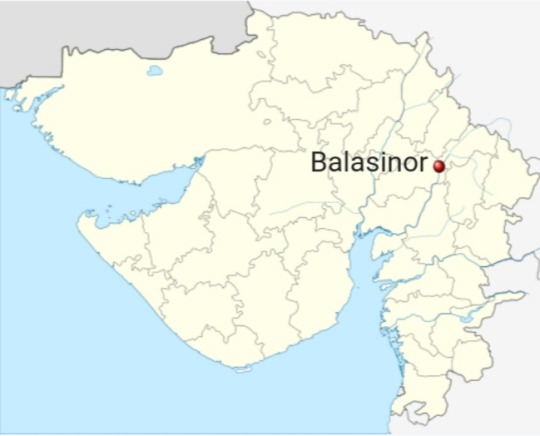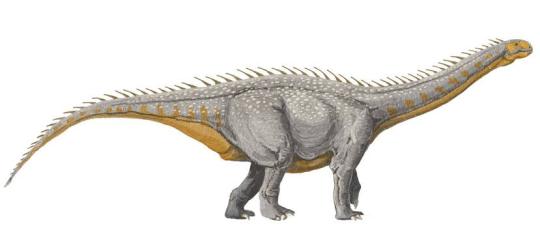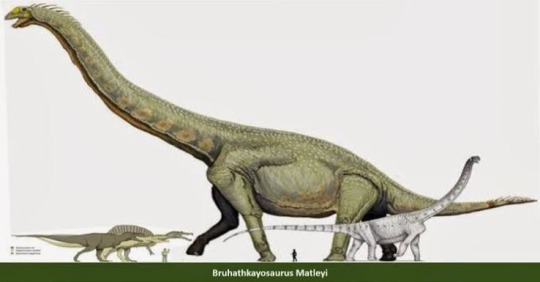#titanosaurus indicus
Explore tagged Tumblr posts
Text
Post # 138
Desi dinosaurs!
Whenever I read the tagline from Steven Spielberg's movie Jurassic Park - "when Dinosaurs ruled the world", I wondered, did they also rule India? Or were these mega-predators only a western phenomenon?
Turns out, between 200 million years and 65 million years ago, more than 20 species of dinosaurs roamed across Meghalaya, Gujarat, Tamil Nadu, Madhya Pradesh and Telangana. It is believed that the largest and the last ever dinosaurs roamed in this part of the world.
Don't believe that? Read on. Because, therein lies a tale.

About 100 kms from Baroda (Vadodara) in Gujarat is an old, sleepy town called Balanisor. 10 km from there is a small village called Raiyoli. Once upon a time, an old woman used to live in Raiyoli. She had magical culinary skills. It was said of her, "Her curries would cure ailments, hypnotize officials, calm the angry and excite the unruffled."
Balanisor also hosted the estate of the former royal family of the 17th century Babi dynasty. The estate has now been converted into a 8-room hotel, managed by Princess Aliya Sultana Babi and her brother.
In October, 2003, young Princess Aliya was on her rounds in her estate, when she passed the old woman’s hut. An intoxicating aroma filled the air and enticed her inside. The princess found the old woman grinding spices with a odd looking mortar and pestle, then mixing them into a curry that was slowly cooking on an earthen stove. Princess Aliya borrowed the pestle from the old woman, studied it and found that it was a dinosaur egg!

In the early 1980s, palaeontologists stumbled upon dinosaur bones and fossils during a regular geological survey of this mineral-rich area. They found dinosaur egg hatcheries and fossils of at least 13 species of dinosaurs, more than 100 million years old. It is now believed that Gujarat is home to one of the largest clutch of dinosaur hatcheries in the world. So well-protected are the fossilised eggs found here that many researchers call them the best-preserved eggs in the world after the ones found in France.
Today Balanisor hosts India's first and only Dinosaur fossil park. It is also called India's Jurassic park. Gujarat tourism officials talk about Dinosaur Tourism and Princess Aaliya, also called the Dinosaur Princess, conducts guided tours of the fossil park.
I was not aware of all of this until I read an interesting book called Quirky History. It contains a chapter on Dinosaurs that are believed to have roamed in India. I checked them out on Google and Wikipedia, and found details about a few pretty interesting breeds.

The first one is named Titanosaurus indicus, the first Indian dinosaur to be discovered, in 1828, by William Henry Sleeman, an administrator with the East India Company, at the base of the Bara Simla Hill near Jabalpur, Madhya Pradesh. This is how the bugger looked.

Another one was called Barapasaurus Tagorei. Bara = Big, Pa = Feet. Almost 300 bones of at least six Barapasaurus were excavated from the present day town of Pochampalli, Telangana, in 1961. Interestingly, the species’ surname, Tagorei, was chosen because the first year of fieldwork on the site at Pochampalli was carried out in the centenary year of Rabindranath Tagore’s birth.

The next one is my favorite. I had a great time reading about it. I was almost ROFL. Its was called Jainosaurus. Quite like the Jains, this dinosaur was a herbivore. But that's not why it's called Jainosaurus. This dinosaur actually gets its name from the palaeontologist Sohan Lal Jain, who worked on figuring out the skull of this animal. Its fossils were also discovered near Jabalpur. The Jainosaurus is especially interesting because it is among the last dinosaur species to live on earth.

Some dinosaurs were named after the places where their fossils were discovered. For example, Jaklapallisaurus was discovered near Jaklapalli in Andhra Pradesh. You can easy guess where Jubbulpuria was found.
One was named Isisaurus, after the Indian Statistical Institute!
I swear guys, I am not making this up. Pls check it out on Google if you wish. :-)
The last one, for now, is Bruhathkayosaurus, from the Sanskrit Bruhath-kaya, which means huge-bodied. It is believed to be the largest dinosaur that ever lived. Its fossils were found in Tiruchirappalli district of Tamil Nadu.

You can check out some of the other species for yourselves - Rahiolisaurus gujaratensis, Rajasaurus, Kotasaurus etc.
I will sign off with a fun fact. In Balasinor, paleontologists have found fossilized remains of a snake that dined on dinosaur eggs. A 67 million-year-old snake skeleton was found in a dinosaur nest, wrapped around a baby dinosaur.
Next time I go to Ahmedabad or Baroda, I must take time out to visit the Dinosaur Fossil Park in Balasinor.

#jurassic park#dinosaur#indian jurassic park#balanisor#raiyoli#babi dynasty#fossils#dinosaur hatcheries#dinosaur tourism#dinosaur princess#quirky history#titanosaurus indicus#barapasaurus tagorie#rabindranath tagore#pochampalli#jainosaurus#jabalpur#jaklapallisaurus#jubbulpuria#isisaurus#indian statistical institute#bruhatkayosaurus#rajasaurus#dinosaur fossil park
7 notes
·
View notes
Photo

About Titanosaurus Titanosaurus is the signature member of the family of dinosaurs known as titanosaurs, which were the last sauropods to roam the earth before the K/T Extinction 65 million years ago. What's odd is that, although paleontologists have discovered plenty of titanosaurs, they're not so sure about the status of Titanosaurus: this dinosaur is known from very limited fossil remains, and to date, no one has located its kull. This seems to be a trend in the dinosaur world; for example, hadrosaurs (duck-billed dinosaurs) are named after the extremely obscure Hadrosaurus, and the aquatic reptiles known as pliosaurs are named after the equally murky Pliosaurus. Titanosaurus was discovered very early in dinosaur history, identified in 1877 by paleontologist Richard Lydekker on the basis of scattered bones unearthed in India (not normally a hotbed of fossil discovery). Over the next few decades, Titanosaurus became a "wastebasket taxon," meaning that any dinosaur that even remotely resembled it wound up being assigned as a separate species. Today, all but one of these species have either been downgraded or promoted to genus status: for example, T. colberti is now known as Isisaurus, T. australis as Neuquensaurus, and T. dacus as Magyarosaurus. (The one remaining valid species of Titanosaurus, which still remains on very shaky ground, is T. indicus.) Lately, titanosaurs (but not Titanosaurus) have been generating headlines, as bigger and bigger specimens have been discovered in South America. The largest dinosaur yet known is a South American titanosaur, Argentinosaurus, but the recent announcement of the evocatively named Dreadnoughtus may imperil its place in the record books. There are also a few as-yet-unidentified titanosaur specimens that may have been even bigger, but we can only know for sure pending further study by experts.
3 notes
·
View notes
Photo

TITANOSAURUS “Titanic lizard” Late Cretaceous, 70 million years ago
Titanosaurus is a genus of extremely large sauropod dinosaur, once applied to a wide variety of species, but now only encompassing two (T. indicus and T. blandfordi). It gives its name, however, to the group Titanosauria, which includes the largest dinosaur ever found, Patagotitan, along with Argentinosaurus, Isisaurus, Rapetosaurus, and many others.
Oh, uh, a punchline... right. Um. It sounds like... “tight... anus... sore?”
Yeah, I'm not proud of that one, either.
#titanosaurus#dinosaur#dinosaurs#saddinosaurfacts#Sauropodomorpha#sauropodomorph#Sauropodomorphs#sauropoda#sauropod#sauropods#titanosauria#titanosaur#titanosaurs#patagotitan#argentinosaurus#isisaurus#rapetosaurus#cretaceous
62 notes
·
View notes
Text
Titanosaurus indicus

Source: http://childfriendlynews.com/lost-fossils-found-in-cupboard
Name: Titanosaurus indicus
Name Meaning: Giant Reptile
First Described: 1877
Described By: Lydekker
Classification: Dinosauria, Saurischia, Eusaurischia, Sauropodomorpha, Plateosauria, Massopoda, Sauropodiformes, Anchisauria, Sauropoda, Gravisauria, Eusauropoda, Neosauropoda, Macronaria, Titanosauriformes, Somphospondyli, Titanosauria
Ah, Titanosaurus! It must be well known given it’s the dinosaur that lent its name to the whole group, right? Right?!
Wrong. It’s a dubious genus, meaning, it’s not really clear if its a separate genus from other titanosaurs or not; it is known from some limb bones and vertebrae and the features that were used to distinguish it from other genera at the time of its naming have been determined to be widespread in many titanosaurs, making it indistinguishable from them. Wooo. It was found in the Lameta Formation in India, and lived in the Maastrichtian age of the Late Cretaceous, about 70 million years ago.
Source:
https://en.wikipedia.org/wiki/Titanosaurus
Shout out goes to @katieprocrastinatey!
#titanosaurus#titanosaurus indicus#dinosaur#sauropod#paleontology#prehistory#prehistoric life#dinosaurs#biology#a dinosaur a day#a-dinosaur-a-day#dinosaur of the day#dinosaur-of-the-day#science#nature#factfile#katieprocrastinatey#恐龙#ديناصور#ڈایناسور#دایناسور#恐竜#דינוזאור#공룡#डायनासोर#ডাইনোসর#risaeðla#dinozor#deinosor#khủng long
38 notes
·
View notes